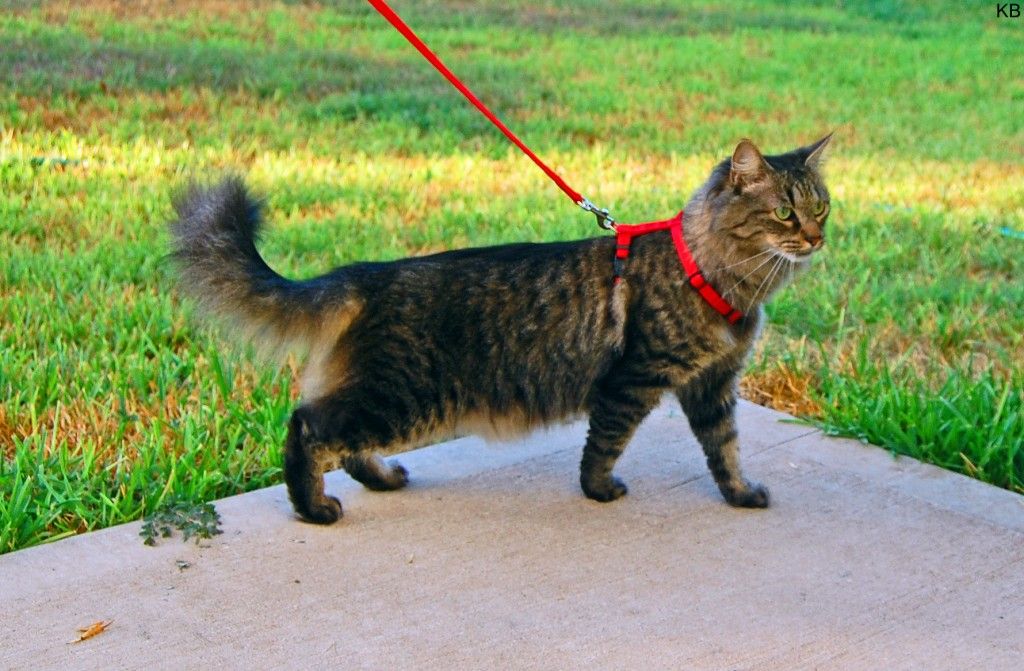How to train your cat to walk on a leash
Have you ever dreamed of walking your cat on a leash? Do you think it's impossible to get your cat to do anything? Well, in reality it's actually quite simple, just follow our simple instructions and your cat will be the envy of the town for years ahead :)
 Cat on leash
Cat on leash
First , a cat is a free-spirited, and practically untamable animal, it will never simply allow you to force it to put on a leash. Not to mention, a cat will always find a way to escape a standard neck only collar. For this purpose, use either a specialized "cat harness" , or a harness leash made for tiny dogs, unless you have a savannah cat.
Second , get the cat very comfortable with the harness. Begin by placing the harness on the cat without a leash. If your cat does responds negatively by sitting down, looking depressed, pet it under the chin to take it's attention away from the foreign object that encases it's body.
Third , add the leash when the cat is comfortable with the harness. It is very important to start at the basics. This can usually be done by taking a piece of fish, or something else your cat loves (like cooked ham maybe) and placing it in front of your beloved kitty. As it goes for the food, gently tug the leash forward, pet the kitty when it gets the ham or fish, keep practicing until the cat simply goes with the tug. Remember to take your time, life is not a race, and the more comfortable your cat is with the leash, the better off you will be when you leave your house.
Fourth , the most crucial step in the process is teaching your cat to walk in sync with you. Try to keep the handle of the leash (probably a retractable one) in front of the cat's head, but sightly angled (like 45 degrees). This way , your cat will walk directly by your side. Start out small, like walking down the sidewalk, or just in your own lawn. Remember that unlike dogs, cats are not use to the whole "endurance" thing, which means that you will have to walk little by little every day, until finally, your cat will be able to tolerate further and further distances.
What to avoid : you need to completely try to avoid scolding the cat if it sits down to take a break. It will let you know that it is tired by sitting on it's hind legs. It is completely natural for the cat to do this, so don't freak out.
Also make sure to hydrate your cat prior to taking it on a walk, cats tend to run dry quicker than dogs, and they tend to drink less. Maybe it would be advisable to bring a small water bowl with you.
If in the beginning stages of training, your cat refuses to move, try to temp it with a toy. Reward it with lots of itching on vulnerable spots , like behind the ears and under the chin. Eventually , it will be more than happy to walk along side you.
 cat dragging - failure -
cat dragging - failure -
When walking with your cat, take care not to let oncoming dogs pounce on it, if a dog owner gets nearby, avoid them. If you can't , picking up the cat is always optional, do everything in your power to keep your cat safe.
Make sure the harness on your cat is not to loose or too tight, you don't want to strangle your cat, or choke it to death , now do you?
Be careful and aware of bicycles, motor scooters or reckless children. If some child threatens to or attempts to hit your cat to show off in front of his friends, grab his arms so he cant get away, grab an enormous branch, and beat his ass until he craps himself. You can then pick up salt off the side of the street and apply it to his raw ass to teach him a lesson. NEVER let a child get away with threatening your cat , and make sure you don't actually hurt the child in any way that will impair it. Always remember, human children are not as important to society as cats.
Anyways, good luck :) Post your success stories below , or send suggestions :)
 Cat on leash
Cat on leashFirst , a cat is a free-spirited, and practically untamable animal, it will never simply allow you to force it to put on a leash. Not to mention, a cat will always find a way to escape a standard neck only collar. For this purpose, use either a specialized "cat harness" , or a harness leash made for tiny dogs, unless you have a savannah cat.
Second , get the cat very comfortable with the harness. Begin by placing the harness on the cat without a leash. If your cat does responds negatively by sitting down, looking depressed, pet it under the chin to take it's attention away from the foreign object that encases it's body.
Third , add the leash when the cat is comfortable with the harness. It is very important to start at the basics. This can usually be done by taking a piece of fish, or something else your cat loves (like cooked ham maybe) and placing it in front of your beloved kitty. As it goes for the food, gently tug the leash forward, pet the kitty when it gets the ham or fish, keep practicing until the cat simply goes with the tug. Remember to take your time, life is not a race, and the more comfortable your cat is with the leash, the better off you will be when you leave your house.
Fourth , the most crucial step in the process is teaching your cat to walk in sync with you. Try to keep the handle of the leash (probably a retractable one) in front of the cat's head, but sightly angled (like 45 degrees). This way , your cat will walk directly by your side. Start out small, like walking down the sidewalk, or just in your own lawn. Remember that unlike dogs, cats are not use to the whole "endurance" thing, which means that you will have to walk little by little every day, until finally, your cat will be able to tolerate further and further distances.
What to avoid : you need to completely try to avoid scolding the cat if it sits down to take a break. It will let you know that it is tired by sitting on it's hind legs. It is completely natural for the cat to do this, so don't freak out.
Also make sure to hydrate your cat prior to taking it on a walk, cats tend to run dry quicker than dogs, and they tend to drink less. Maybe it would be advisable to bring a small water bowl with you.
If in the beginning stages of training, your cat refuses to move, try to temp it with a toy. Reward it with lots of itching on vulnerable spots , like behind the ears and under the chin. Eventually , it will be more than happy to walk along side you.
 cat dragging - failure -
cat dragging - failure -When walking with your cat, take care not to let oncoming dogs pounce on it, if a dog owner gets nearby, avoid them. If you can't , picking up the cat is always optional, do everything in your power to keep your cat safe.
Make sure the harness on your cat is not to loose or too tight, you don't want to strangle your cat, or choke it to death , now do you?
Be careful and aware of bicycles, motor scooters or reckless children. If some child threatens to or attempts to hit your cat to show off in front of his friends, grab his arms so he cant get away, grab an enormous branch, and beat his ass until he craps himself. You can then pick up salt off the side of the street and apply it to his raw ass to teach him a lesson. NEVER let a child get away with threatening your cat , and make sure you don't actually hurt the child in any way that will impair it. Always remember, human children are not as important to society as cats.
Anyways, good luck :) Post your success stories below , or send suggestions :)
Stay Informed
When you subscribe to the blog, we will send you an e-mail when there are new updates on the site so you wouldn't miss them.
